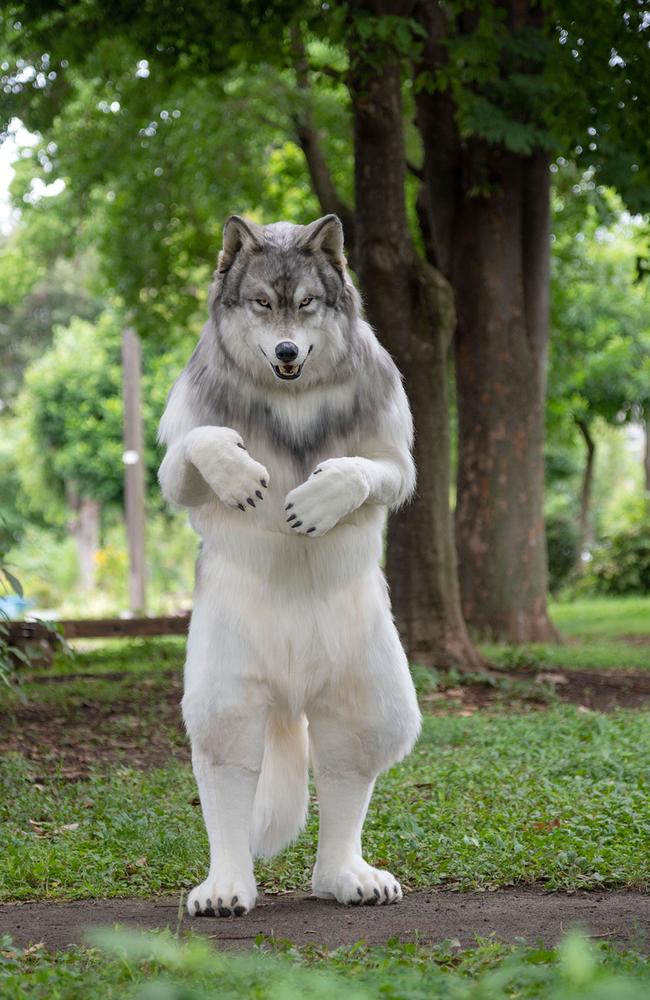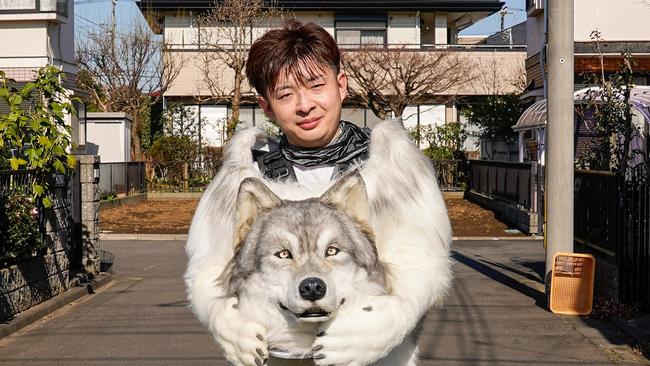‘Human collie’ part of a larger pack of ‘therians,’ psychologists say
Toco, the Japanese man who enjoys dressing as a rough collie, could be part of a larger movement of people known as therians, experts have said.
Lifestyle
Don't miss out on the headlines from Lifestyle. Followed categories will be added to My News.
Toco, the Japanese man who enjoys dressing as a rough collie, is part of a larger pack.
Psychologists believe Toco might be a therian, the New York Post reports, someone who identifies as a non-human animal species.
That’s not the same as a furry, who enjoys occasional cosplay in an animal costume or “fursuit”, experts said.
It’s important “to distinguish between furries, who are fans of anthropomorphic animals … and therians, who on some level identify as a creature other than human,” associate professor of psychology at Pittsburgh’s Duquesne University, Dr Elizabeth Fein, told The Post.
Therians “might, for example, believe that they are a cat soul reincarnated into a human body”, Dr Fein added. “Some furries are therians, and some therians are furries, but they are two distinct groups.”

The history of therians goes back many centuries and is often intertwined with ancient beliefs in human-animal hybrids, including human-goat satyrs, the elephant-headed Indian god Ganesha, werewolves and other legendary beings.
“Therian” is a shortened form of “therianthrope”, which comes from the Ancient Greek word ther, meaning “wild beast”, and anthropos, or “human being”.
Many of these ancient legends involve canines like wolves, foxes, jackals and dogs. To this day, lycanthropy, or the belief in a human/canine being, remains very popular among thespians.
People who identified as animals were largely isolated from one another until the emergence of internet chat rooms, which allowed the formation of groups dedicated to furries and therians.
Soon, conventions like Midwest FurFest – which in 2022 welcomed thousands of participants from over 50 countries – were popping up worldwide.

Naia Ōkami, a Seattle-area therian who occasionally dresses in wolf ears and a tail, volunteers at wolf preserves to bond with the animals.
“So spiritually and psychologically, I identify as a wolf, but I know I’m human,” Ōkami told the Daily Mail. “I walk on two legs, I’ve got a job, I’ve got a career. My partner is human.”
“For me, I would explain it as being a wolf in a human body,” lycanthrope Shiro Ulv told Pacific Standard.
“Everything else – my mind, my soul – is wolf. I’ll growl sometimes, I’ll bark sometimes, and I’ll howl sometimes.
“I’m pretty open, but a lot of people will hide it, and for good reason. When I was in high school, I was severely bullied.”

Therians – sometimes called “otherkins” – face numerous obstacles.
“Challenges are many, probably first and foremost because they are generally not accepted by society as therians,” Niagara County Community College professor emeriti in psychology, Dr Kathleen C Gerbasi, told The Post.
“It is a burden to hide their true authentic identity. Some report ‘putting on human’ in order to fit into regular society.”
Dr Gerbasi has spent years studying the therian, furry and otherkin community with the International Anthropomorphic Research Project (IARP).
Research by the IARP revealed that a majority of furries are younger than 25, white and male, with at least some tertiary education. Nearly half live with their parents, and most define themselves as politically liberal.
And the most popular “fursonas”, or furry personas, according to the IARP survey, are wolves, foxes and dogs, followed by big cats (tigers, lions and snow leopards), dragons and domestic cats.
A similar study from the University of California found that – in addition to being predominantly young, white males – only one-third of furries identified as heterosexual. Almost 63 per cent identified as bi or homosexual.
“Being able to say, ‘I am not gay, my fursona is’, is a way to express this aspect of their identity while simultaneously distancing themselves from the stigma it carries,” the IARP report authors wrote.

And the illustrations and websites popular among the furry and therian communities often contain “adult-themed” sexual content.
“This is not to say, of course, that the furry fandom is purely sexual or a fetish,” the study authors wrote.
“However, it does provide evidence that adult content is popular in the fandom, rather than something enjoyed by only a small minority of the fandom.”
There’s no consensus on whether people who identify as therians or furries have mental or behavioural disorders, and they resist being categorised as mentally ill.
Ōkami, for one, rejects the idea that she or other therians have a problem.
“Mental health issues are judged by how they’re affecting your performance in society. Are they affecting your daily living skills? Are they affecting your ability to have a career? Being a therian does none of those things,” Ōkami said.
The IARP report revealed that rates of anxiety, depression and other mood disorders are no more common among furries than in the general population.
Similarly, “furries were also no more likely to be diagnosed with [ADHD], to have been prescribed psychotropic medication or to have been diagnosed with a medical condition”, the authors wrote.
“These findings coincide with other data showing that furries are no more likely to experience dysfunctional fantasy or delusion than non-furries.”

The only condition that occurred more frequently among furries is Asperger’s syndrome, a high-functioning form of autism spectrum disorder.
People with Asperger’s may have a hard time relating to other people socially, and their thinking may be rigid and repetitive, according to the Nationwide Children’s Hospital.
Other research, conducted by Helen Clegg of the UK’s University of Northampton, suggests some therians may have higher levels of schizotopy, or schizotypal personality disorder (STPD).
STPD is a condition marked by intense discomfort with social interactions and personal relationships. Those with STPD often “have distorted views of reality, superstitions and unusual behaviours”, according to the Cleveland Clinic.
This article originally appeared on the New York Post and was reproduced with permission
Originally published as ‘Human collie’ part of a larger pack of ‘therians,’ psychologists say




